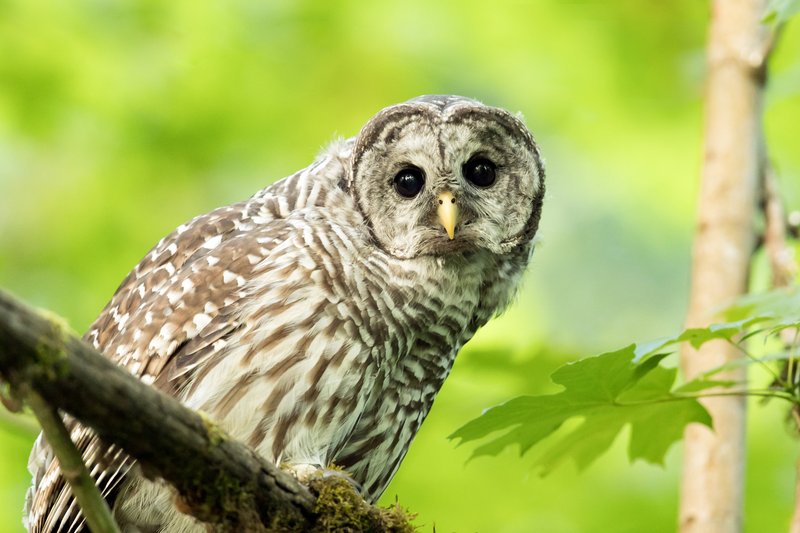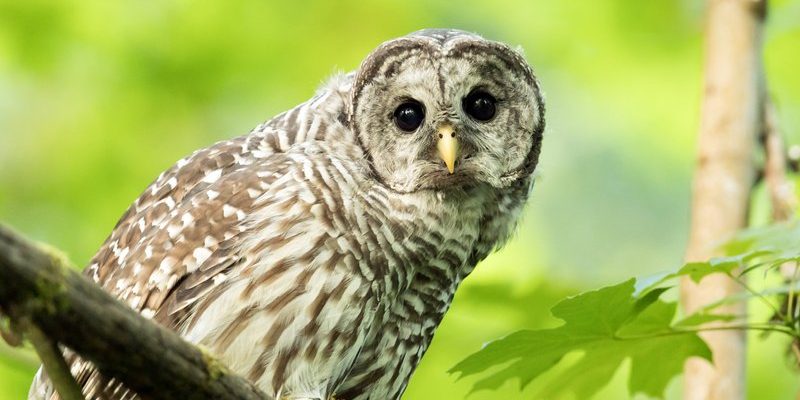
You might be surprised to learn that the Barred Owl’s story is rich with changes and adaptations, much like the chapters of your favorite book. The journey of these owls is not just about survival; it’s also about how they’ve thrived alongside changes in the environment and human interaction. So, grab a cup of coffee and let’s dive into the story of the Barred Owl, from its origins to its current role in the ecosystem.
The Origins of the Barred Owl
The Barred Owl (*Strix varia*) has roots that trace back thousands of years. Paleontologists believe that the owls we see today are part of a larger family that includes species from around the world. The Barred Owl likely evolved in North America during the late Pleistocene epoch, a time when it shared habitat with giant mammals and fierce predators.
These owls adapted to thrive in dense, mature forests, which provided ample hunting grounds and nesting sites. Their diet, primarily consisting of small mammals, birds, and even amphibians, helped them dominate as nocturnal hunters. You could think of them as the night’s silent ninjas, going about their business without being seen or heard. Their ability to regulate their body temperature and stay active at night made them well-suited for their environment, ensuring their survival even as the climate began to change.
As time went on, Barred Owls began to spread across North America, moving from the eastern forests into the western regions. This introduction to new habitats contributed to diversifying their genetic pool, making them even more resilient. Over the centuries, Barred Owls have adapted to a range of environments, from swamps to mixed forests, developing a strong presence across the continent.
Physical Characteristics and Adaptations
Barred Owls are easily recognizable thanks to their unique markings. Their feathers are a mix of dark brown and white, forming bars that run horizontally across their body. This pattern not only makes them appealing but also serves a practical purpose—providing camouflage within their forest surroundings. It’s like wearing a natural set of pajamas that help them blend in!
Their large, rounded heads and forward-facing eyes give them excellent depth perception, crucial for hunting in low light. Their exceptional hearing allows them to detect the slightest rustle of prey hiding among the leaves. Have you ever tried to tune into sounds around you at night? That’s basically what a Barred Owl does, listening for even the faintest movements.
Another fascinating adaptation is their silent flight. Their wing feathers have serrated edges that reduce turbulence and help them glide silently through the air. This stealthy approach is vital as they swoop down on unsuspecting prey. Honestly, the next time you hear one of their calls, try to listen for the quiet flaps of their wings—it’s a real testament to how nature engineers such amazing creatures.
Behavior and Social Structure
Barred Owls are known for their distinct social structures and behaviors. These owls are typically monogamous, forming lifelong pairs that work together to defend their territory and care for their young. When you see two Barred Owls perched together, it’s likely they’ve weathered many seasons side by side, navigating the ups and downs of their environment as a team.
Their vocalizations are particularly interesting. The classic “Who cooks for you?” call is not just a melody; it serves as a vital communication tool between mates and rivals. Let’s face it: if you had a catchy tune for calling your buddy, you’d use it often too! Barred Owls are also known to mimic other birds, using these sounds to either lure in prey or ward off intruders from their territory.
Interestingly, they often hunt alone but will sometimes cooperate with their partner during the breeding season. This teamwork allows them to maximize their chances of success, ensuring that their young have enough food to grow strong and healthy. Imagine two friends out on a fishing trip; working together often leads to better catches!
Habitat and Range
Barred Owls thrive in a variety of habitats, though they prefer mature forests with dense canopies. They can be found in both deciduous and coniferous forests, swamps, and even urban areas. This adaptability has played a significant role in their spread across North America, from southern Canada all the way down to the southeastern U.S.
Their range has expanded notably over the past century, primarily due to deforestation and habitat changes. Surprisingly, Barred Owls have taken well to suburban areas where large trees and open spaces exist. You might find them nesting in park trees or even around old barns. It’s as if they’ve decided, “Why not make the most of the opportunities we have?”
However, this expansion has not come without complications. Barred Owls are known to displace the smaller Spotted Owl, particularly in the Pacific Northwest. It’s a bit like a game of musical chairs—when one species takes over, it can push the other out of its rightful place. This ecological shift raises concerns about biodiversity and the balance within forest ecosystems.
Conservation Status and Threats
While the Barred Owl is currently not listed as endangered, its populations face numerous threats. Habitat loss due to logging, urbanization, and climate change can significantly affect their numbers. Additionally, competition with other owl species can lead to declines in local populations, especially for the Spotted Owl.
Conservation efforts are underway to monitor and protect these majestic birds. Organizations and wildlife agencies often focus on preserving their habitats and managing ecosystems to ensure the coexistence of various owl species. Here’s the thing: when we protect one species, we often help many others thrive as well.
Education plays a critical role too. By raising awareness about the importance of Barred Owls and their habitats, communities can get involved in conservation efforts. So next time you hear that distinctive call in your neighborhood, remember that it’s not just an owl; it’s a vital part of our ecosystem.
The Barred Owl in Culture and Folklore
Throughout history, Barred Owls have captured the imagination of people across cultures. In many Native American traditions, owls symbolize wisdom and protection. Their nocturnal habits and keen eyesight have made them intriguing figures in folklore, often seen as messengers between the living and the spirit world.
In literature and art, Barred Owls often embody mystery and magic. You might recall a poem or a story that speaks to their ethereal beauty and wisdom. Writers and artists have long been inspired by their unique calls and graceful flights. The question is, what do these creatures mean to you? Maybe the next time you hear their song, you’ll think of the stories and lessons they carry through the ages.
In modern culture, Barred Owls have become symbols of the need for wildlife conservation. Their presence in our backyards encourages us to appreciate and understand the natural world around us. As we learn more about them, we become advocates for their survival, ensuring that future generations will also get to experience the magic of this remarkable bird.
The Barred Owl is more than just a bird of the night; it’s a symbol of resilience and adaptability in the face of change. Their evolution and history remind us of the delicate balance within ecosystems and the importance of conservation. Through understanding and protecting the Barred Owl, we help preserve the natural beauty that enriches our lives.
So, the next time you’re out in the woods or even enjoying a quiet evening in your backyard, listen closely. You might just hear that melodious call echoing through the trees. And remember, every time you hear it, you’re not just hearing an owl; you’re witnessing a story that has been unfolding for thousands of years—one that we can all be a part of if we take the time to care.

